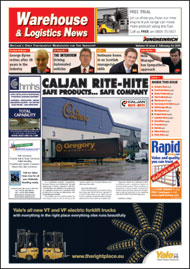 VIEW THIS ‘DIGITAL EDITION’ NOW
VIEW THIS ‘DIGITAL EDITION’ NOW
SIGN UP TO THE REMINDER SERVICE
Welcome to the 1 February Warehouse & Logistics News. Whether you live in Washington DC, or Washington, County Durham, the biggest news at the moment has to be Barack Obama’s inauguration as the 44th President of the USA. We’ve had since November to come to terms with this, and now it’s here. The election of a man of mixed race as President is a milestone for America, with its sad history of slavery, then segregation, and in our days, the continuing major gap in life prospects between black people and white people. Here we’ve had waves of immigration from all over the world, which have caused any number of social problems that we’re still dealing with. Equal opportunity legislation here and in Europe means that in the workplace things are more equal than they were, but we still have a long way to go. Against this background then, Barack Obama’s election for his ability, first and foremost, rather than his family background is a symbol of a new hope. One message it sends to employers and workforces alike is that the colour of a person’s skin or where they come from should not affect their job prospects. It would be great for the warehouse and logistics industry to lead in seeing fair play in this important area. Businesses have their social responsibilities, but the bottom line is that the people running them and investing in them are there to make a profit. Otherwise, as we’re sadly seeing with so many companies in the current recession, they go out of business. Efficiency and performance play a key role in companies’ continuing prosperity, and materials handling technology is central to it. The materials handling machinery we rely on in today’s warehouses and distribution centres has come into being because there’s a limit to the workforce’s ability to lift and carry weights, on one hand, and the need to be more productive on the other. If you think about structures like the pyramids or Stonehenge, it’s clear that since the earliest times mankind has been enhancing their natural capacity to move objects with a combination of tools – levers, pulleys and hoists, rollers of various kinds and, crucially, the wheel. The industrial accidents of ancient times must have been horrendous. These days, in increasing numbers of countries, employers’ responsibility for their workforce’s wellbeing is enshrined in Health & Safety legislation. But the business concerned, the criteria for effective materials handling remains the difference the equipment makes in terms of performance and profitability. In this issue we help you improve your materials handling performance with two scheduled features, Fork Trucks and Conveying & Sortation. Our first look of 2009 at all things fork truck Includes warehouse trucks, outdoor trucks and specialist machines, and brings you the latest news from Yale and Clark and other major players in the industry. Our other feature, Conveying & Sortation, looks at Automated materials handling equipment and IT solutions. The lynchpin of the feature is an interview with Soft Design. Soft Design AB is a leading Automated Guided Vehicle (AGV) supplier based in Gothenburg Sweden, with over 20 years’ experience in the AGV business. For many years Sweden has been thought of as the birthplace of modern AGV technology, with Volvo leading the way in the mid 1970s. AGVs are also known as Laser Guided Vehicles (LGV) or Self Guided Vehicles (SGV). Soft Design supplies AGV systems throughout Europe, either to major system integrators or direct to customers, delivering the high quality AGV manufacturing and software associated with Swedish suppliers. As Soft Design’s European Sales Manager Tony Hughes says, AGVs at work are an amazing sight: anyone seeing them in action for the first time cannot fail to be mesmerised as these unmanned vehicles move around carrying pallets or products from A to B. AGVs are highly impressive, and the perception is often one of futuristic technology that can lift a company’s image, but it’s important not to lose sight of the fact that besides being technological marvels, they serve an important purpose. They work without breaks or holidays 24 hours a day, 7 days a week, 365 days a year, and while many companies have not considered implementing AGVs, thinking they may be too expensive an option for them, this is quite often not the case. Once a customer installs an AGV system, it is highly likely it will last for 20 years or more. Will AGV’s form part of your plans for your operation’s future success? Have a successful month, and happy reading! Charles Smith




Comments are closed.